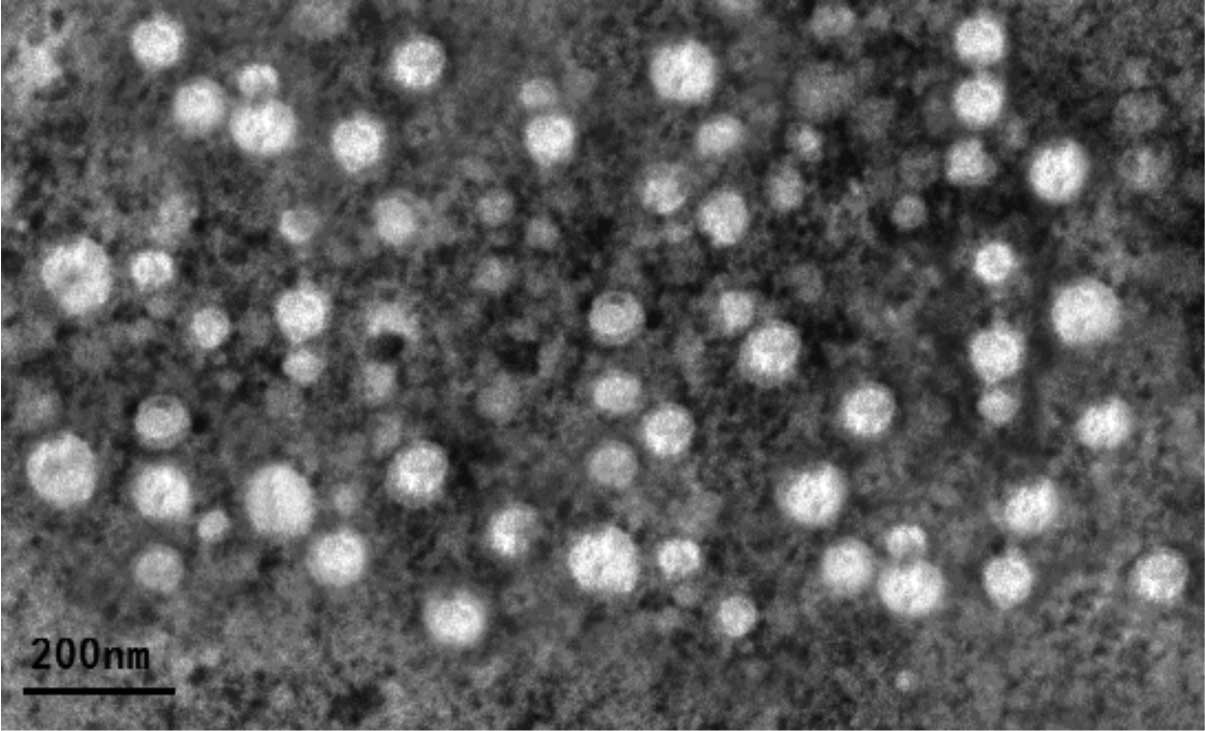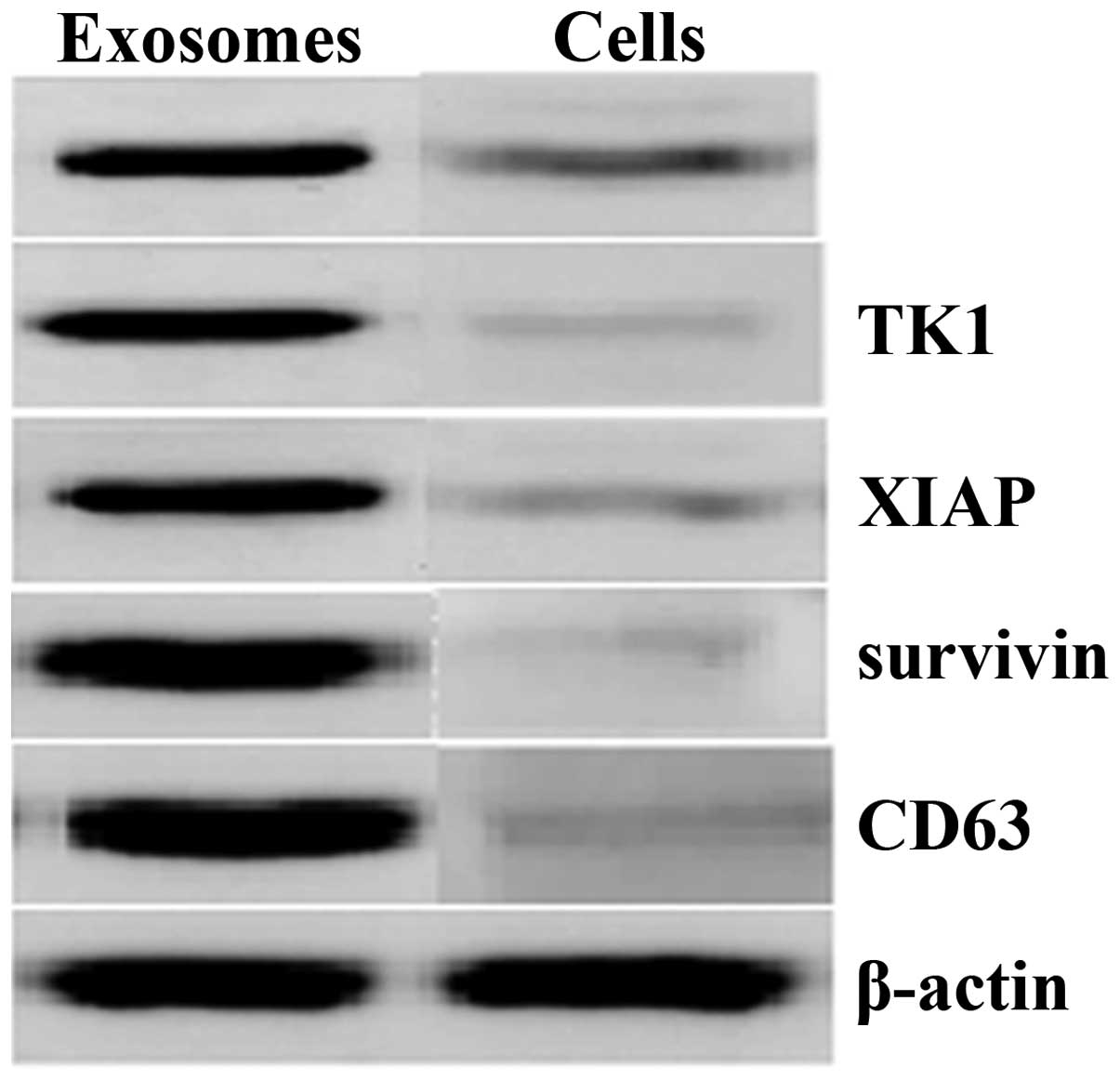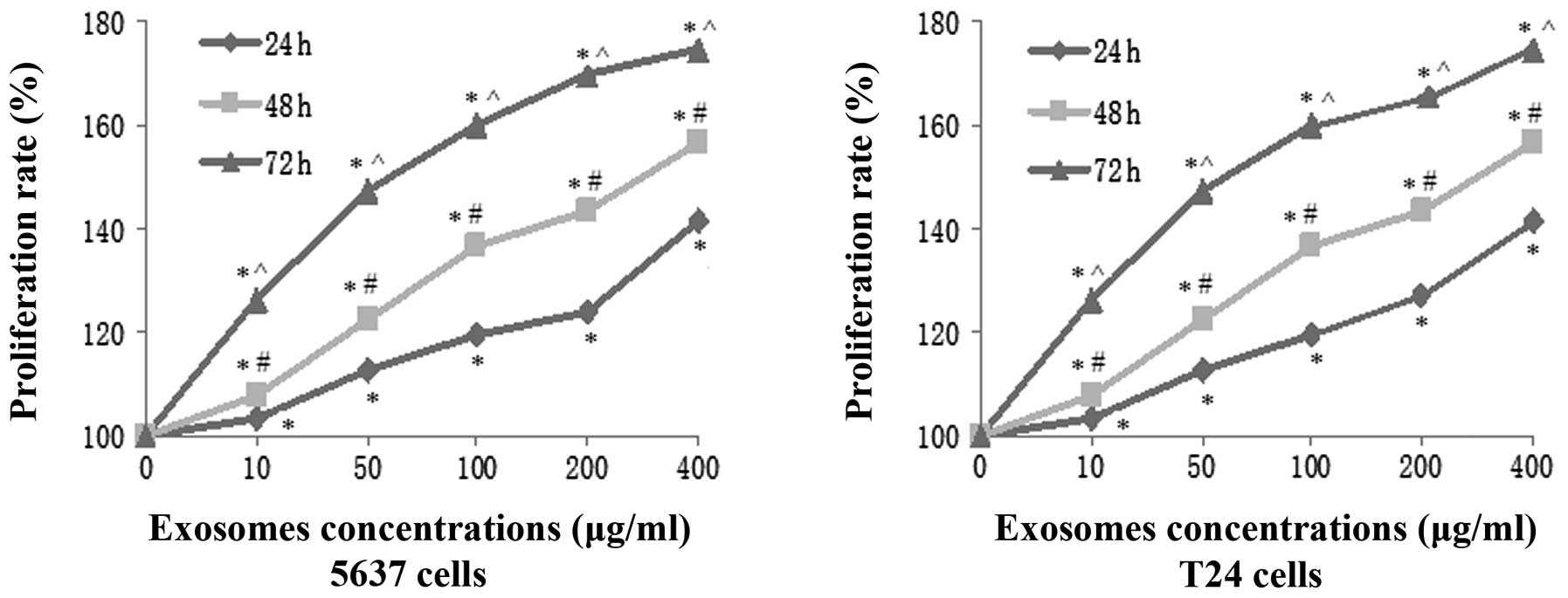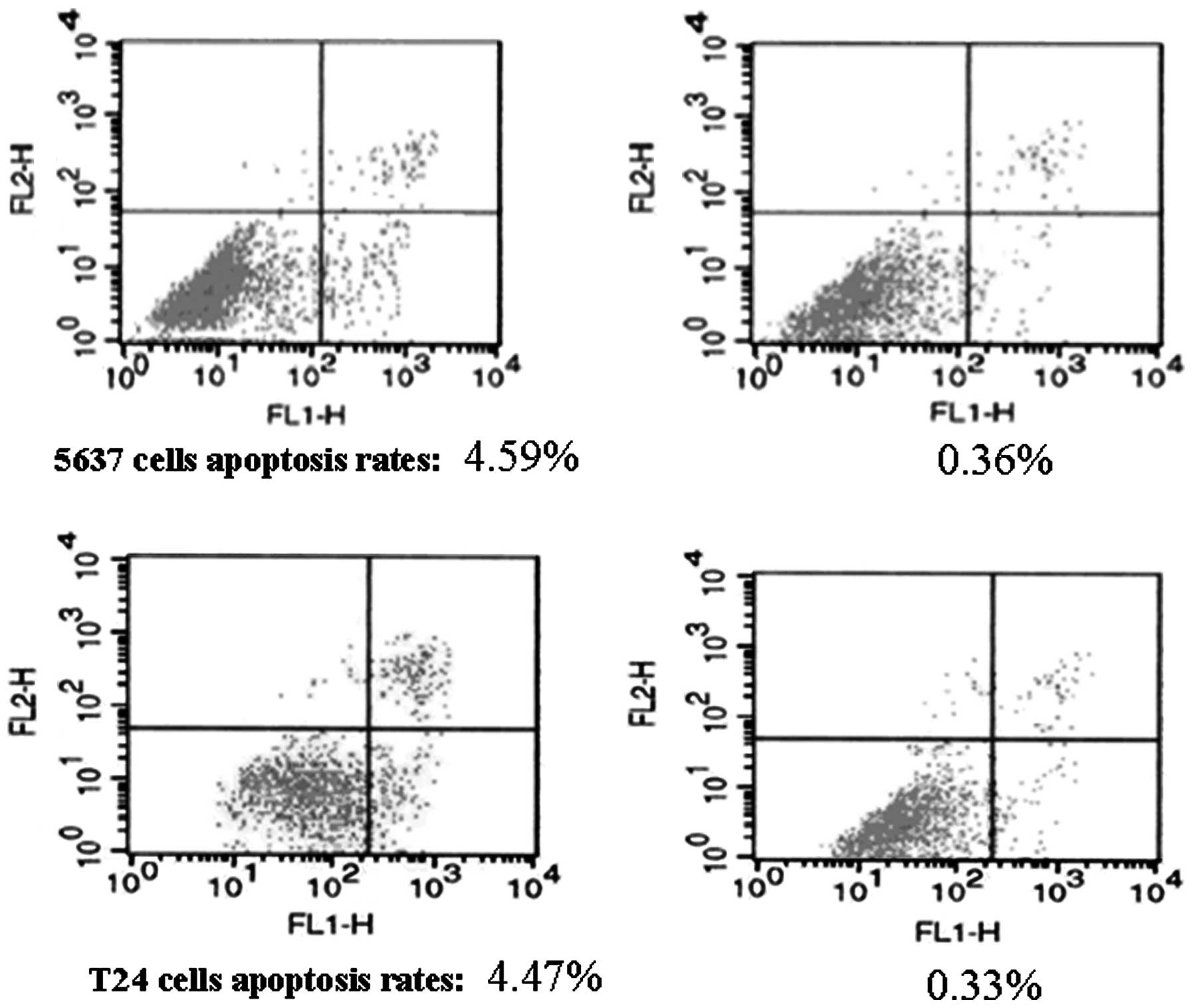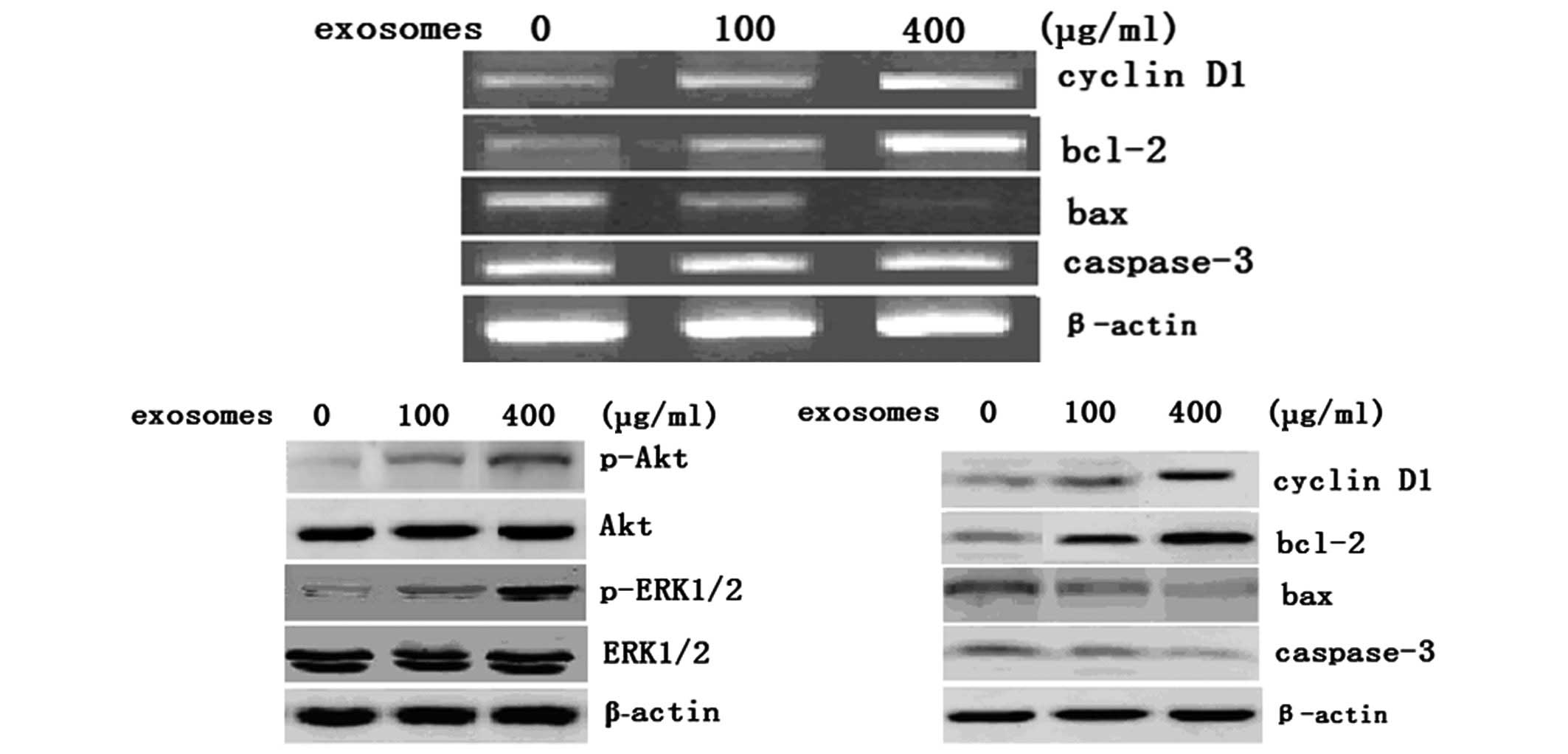Bladder cancer cell-derived exosomes inhibit tumor cell apoptosis and induce cell proliferation in vitro
- Authors:
- Published online on: August 14, 2013 https://doi.org/10.3892/mmr.2013.1634
- Pages: 1272-1278
Abstract
Introduction
Bladder cancer is a significant health problem, accounting for ~7% of all human malignancies. It is the eighth most common cause of cancer-related mortality worldwide, with an estimated 70,980 novel cases and 14,330 deaths annually (1). Regardless of recent advancement in multidisciplinary therapeutic strategies, bladder cancer remains associated with relapse and deterioration (2). Therefore, defining the factors involved in disease progression may aid in the identification of novel strategies for the development of effective therapies against bladder cancer.
The present study investigated exosomes, which are small membrane vesicles, 30–100 nm in diameter, released by a variety of mammalian cells into the extracellular space upon direct fusion of the multi-vesicular bodies with the plasma membrane (3). Exosomes contain lipids, proteins and nucleic acids from their cell of origin, contents of which are transferred to target cells and affect their function and activity (4). Thus, exosomes may be involved in cell-to-cell signaling. Several pioneering studies have investigated the involvement of exosomes in reticulocyte maturation and immune cell functions (5–6). Recently, it has been suggested that exosomes are also involved in a number of physiological and pathological processes, including cancer (7). Numerous tumor cells produce exosomes, which are emerging as a potential utility for the early detection or control of human cancer (8–11). Previous studies have demonstrated that exosomes derived from tumor cells possess anti-tumor properties, such as inducing tumor cell apoptosis (12) and enhancing anti-tumor immunity (13). Exosomes have also been extensively studied as a novel cell-free source of tumor antigens to develop anti-cancer vaccines (14–15) However, it is increasingly suggested that exosomes may also affect tumor progression by exhibiting immunosuppressive properties, facilitating tumor invasion and metastasis, stimulating tumor cell proliferation or inducing drug resistance (16) A recent study showed that gastric cancer-derived exosomes promoted tumor cell proliferation and activated the mitogen-activated protein kinase/extracellular signal-regulated kinase (MAPK/ERK) and lipid kinase phoshoinositide-3-kinase (PI3K)/Akt signaling pathways (17).
To demonstrate the effects of bladder cancer cell-derived exosomes on the regulation of tumor cell growth and apoptosis, exosomes were isolated from bladder cancer cells and their effects in bladder cancer cell lines were investigated in vitro. It was demonstrated that bladder cancer cell-derived exosomes promoted bladder cancer cell proliferation, but inhibited apoptosis. In addition, exosomes were able to activate Akt and ERK pathways. Thus, the results of the present study provide a novel mechanism by which bladder cancer cell-derived exosomes participate in tumor progression.
Materials and methods
Cell lines and culture
T24 and 5637 human bladder cancer cell lines were provided by Professor Chun-Li Luo from the Department of Medical Diagnostics, College of Laboratory Medicine, Chongqing Medical University (Chongqing, China). Cells were cultured in RPMI-1640 (Gibco-BRL, Grand Island, NY, USA) supplemented with 10% heat-inactivated fetal bovine serum (Gibco-BRL), penicillin (100 U/ml) and streptomycin (100 g/ml) at 37° C with 5% CO2 in a humidified incubator. The cells were routinely passaged and cells at the logarithmic growth phase were used for the experiments.
Exosome isolation
The supernatants of T24 cells were collected and sequentially centrifuged at 4°C at 300 × g for 10 min, 800 × g for 30 min and 10,000 × g for 30 min to remove cells and debris (Ultracentrifuge CP100WX; Hitachi, Tokyo, Japan). The supernatants were subjected to ultrafiltration concentration using a 100 kD MWCO Centriplus centrifugal ultrafiltration tube (Amicon, Pineville, LA, USA) at 1,000 × g for 30 min. The remaining supernatants were further concentrated and subjected to ultracentrifugation on a centrifugal ultrafiltration tube containing 30% sucrose in heavy water (Tenglong Weibo Technology, Qingdao, China) at 100,000 × g for 1 h at 4°C. The sucrose solution was collected and diluted with double distilled water, followed by concentration using another 100 kD MWCO Centriplus centrifugal ultrafiltration tube at 1,000 × g for 30 min. The remaining exosome-containing solution was collected, filtered through a 0.22-μm filter, aliquoted and stored at −80°C.
Transmission electron microscopy
To confirm the successful isolation of exosomes, a transmission electron microscope (JEM-2010, Jeol Ltd., Tokyo, Japan) was utilized to examine the morphology of the exosomes using a standard protocol. Briefly, a 20-μl drop of exosome suspension (~100 μg/ml) was loaded onto a copper grid to form a monolayer (staining for 1 min). Excess solution was soaked out with clean filter paper. Subsequently, the sample was stained with a 20-μl drop of 2% phosphotungstic acid (12067-99-1; Damao Chemical Reagent Factory, Tianjin, China) for 1 min and allowed to dry under an electric incandescent lamp (Jia Yao Lighting Co., Ltd., Foshan, China) for 10 min. The sample was reviewed under a transmission electron microscope and images were captured (JEM-2010; Jeol, Tokyo, Japan).
Tumor cell proliferation assay
The tumor cell proliferation assay was conducted using a Cell Counting kit-8 (CCK-8; Qi-hai Biotech, Co., Shanghai, China). Briefly, 5637 and T24 cells were seeded at 1,000 cells/well in 96-well culture plates and co-cultured with increasing concentrations of exosomes (10, 50, 100, 200 and 400 μg/ml). Cells treated with an equal volume of phosphate-buffered saline (PBS) served as controls and vials without cells were used as blank controls. Following exosome treatment for 24, 48 and 72 h, 10 μl CCK-8 solution was added to the culture medium and incubated for an additional 2 h. Subsequent to this, the optical density of the cells was measured with a spectrophotometer (Type 752; Shanghai Yuanxi Instruments Co. Ltd., Shanghai, China) at an absorbance of 450 nm. The cell proliferation rate was calculated using the following formula: proliferation rate = (experimental OD value − blank OD value) / (control OD value − blank OD value) × 100%.
Annexin V apoptosis assay
To detect tumor cell apoptosis, an Annexin V-fluorescein isothiocyanate (FITC)/propidium iodide apoptosis detection kit (Invitrogen Life Technologies, Carlsbad, CA, USA) was used according to the manufacturer’s instructions. Specifically, 5637 and T24 cells were seeded into six-well plates, cultured for 24 h and treated with various concentrations of exosomes (10, 50, 100, 200 and 400 μg/ml) at different time points (24, 48 and 72 h). Cells treated with an equal volume of PBS served as a control. The treated and control cells were mixed with 5 μl Annexin V-FITC and 10 μl of 20 μg/ml PI reagents. The cells were then incubated at room temperature in the dark for 20 min. After adding 400 μl PBS, the samples were subjected to flow cytometry analysis to detect cell apoptosis levels. Cells positive for Annexin V-FITC, but negative for PI fluorescence, were considered to represent apoptotic cells.
Reverse transcription polymerase chain reaction (RT-PCR)
Total cellular RNA was isolated from treated and control tumor cells using TRIzol reagent (Invitrogen Life Technologies) according to the manufacturer’s instructions. Following quantification, the RNA samples were reverse transcribed into cDNA using an RT-PCR kit (PrimeScript™ One Step RT-PCR Kit Ver.2, DRR055S; Takara, Dalian, China) according to the manufacturer’s instructions. PCR amplifications were conducted at 94°C for 5 min, 35 cycles at 94°C for 30 sec, 58°C for 40 sec and 72°C for 50 sec, with a final extension at 72°C for 5 min. The primers used were as follows: Forward, 5′-GTAGCAGCGAGCAGCAGAGT-3′and reverse, 5′-CGGTCGTTGAGGAGGTTGG-3′ for cyclin D1; forward, 5′-CCTAGCGGATGGGTGCTATT-3′ and reverse, 5′-CGAGGTGGCAAAACAAACA-3′ for caspase 3; forward, 5′-CGGCGAATTGGAGATGAA-3′ and reverse, 5′-GTGTCCACGTCAGCAATCAT-3′ for Bax; forward, 5′-CATGCCGTCCTTAGAAAAATACA-3′ and reverse, 5′-CTGCTTTTTATTTCATGAGGTACATT-3′ for Bcl-2; and forward, 5′-AGCGAGCATCCCCCAAAGTT-3′ and reverse, 5′-GGGCACGAAGGCTCATCATT-3′ for β-actin. The PCR products were then resolved by electrophoresis in a 1.5% agarose gel. Subsequently, the data were quantified using a gel imaging system (Vilber Lourmat, La Vallée, France).
Protein extraction and western blot analysis
Bladder cancer T24 cells treated with exosomes were lysed in a lysis buffer containing protease inhibitors for 30 min at 4°C. Total cellular lysates were then centrifuged at 15,000 × g for 30 min and the protein concentrations of the lysates were determined using the Bradford method (18). To analyze the expression of exosome proteins, 40 μl exosome suspension was sonicated, mixed with sample buffer and boiled for 5 min. Subsequently, equal quantities of protein samples (10 μg) were separated by sodium dodecyl sulfate polyacrylamide gel electrophoresis, followed by transferring onto polyvinylidene fluoride membranes (Millipore, Bedford, MA, USA) at 250 mA. The membranes were then blocked with 5% non-fat dry milk (w/v) in Tris-buffered saline with 0.1% Tween-20 (TBST) for 2 h at room temperature and immunoblotted overnight at 4°C using rabbit anti-human basic fibroblast growth factor (bFGF), rabbit anti-human X-linked inhibitor of apoptosis protein (XIAP), rabbit anti-human survivin (Biovision, Palo Alto, CA, USA), mouse anti-human thymidine kinase 1 (TK1; Abnova, Taipei, Taiwan), rabbit anti-human CD63, mouse anti-human Bcl-2, mouse anti-human Bax, rabbit anti-human cyclin D1, rabbit anti-human caspase-3 (Santa Cruz Biotechnology, Inc., Santa Cruz, CA, USA), rabbit anti-human Akt and phospho-Akt1/2 (Ser 473) or rabbit anti-human ERK and phospho-ERK1/2 (Cell Signaling Technology, Danvers, MA, USA) antibodies. Following three rinses with TBST at 15 min intervals, the membranes were further incubated for 1 h with horseradish peroxidase-labeled goat anti-rabbit or anti-mouse IgG (Zhongshan Golden Bridge, Beijing, China). The positive protein bands were detected using an enhanced chemiluminescence (ECL) plus chemiluminescence kit (P0018; Beyotime Institute of Biotechnology, Haimen, China).
Statistical analysis
Each experiment was repeated at least three times. All data are presented as the mean ± SD. Student’s t-test was used to compare the differences between two groups. All statistical analyses were performed using SPSS 17.0 software (SPSS Inc., Chicago, IL, USA). P<0.05 was considered to indicate a statistically significant difference.
Results
Isolation and characterization of bladder cancer T24 cell-derived exosomes
In the present study, exosomes were purified from T24 cells by sequential centrifugation and ultrafiltration, and their identity was confirmed under a transmission electron microscope. The data showed that these exosomes were round-shaped vesicular membrane structures, 30–100 nm in diameter (Fig. 1). In addition, western blot analysis demonstrated that XIAP, survivin, bFGF, TK1 and CD63 were abundant in these isolated exosomes compared with the whole-cell lysates of T24 cells (Fig. 2).
Bladder cancer cell-derived exosomes promote tumor cell viability
To determine the effects of T24 cell-derived exosomes on the regulation of renal clear cell carcinoma cell proliferation, the viability of 5637 and T24 cells was analyzed following treatment with various concentrations of exosomes (10, 50, 100, 200 and 400 μg/ml) for up to 72 h. The results of the cell viability CCK-8 assay showed that these exosomes significantly induced the viability of 5637 and T24 cells in a time- and dose-dependent manner (Fig. 3). A maximal increase in tumor cell proliferation was achieved following treatment with 400 μg/ml exosomes for 72 h, and the viabilities of 5637 and T24 cells were increased by 76.52% and 73.26%, respectively.
Bladder cancer cell-derived exosomes inhibit tumor cell apoptosis
To investigate the potential cause of the induced tumor cell viability by the exosomes, an Annexin V/flow cytometric apoptosis assay was performed following the treatment of 5637 and T24 cells with increasing concentrations of exosomes (10, 50, 100, 200 and 400 μg/ml) for up to 72 h. It was demonstrated that these exosomes dose- and time-dependently inhibited the apoptosis of 5637 and T24 cells, with the maximal reduction occurring following treatment with 400 μg/ml exosomes for 72 h (Table I, Fig. 4). Moreover, the expression of apoptosis-related genes was analyzed in these cells. As shown in Fig. 5, the levels of Bcl-2 mRNA and protein were increased following 100 and 400 μg/ml exosome treatment for 72 h, whereas the levels of Bax mRNA and protein were markedly reduced in these cells. In addition, downregulation of caspase-3 protein, an executioner of apoptosis, was observed. However, the levels of caspase-3 mRNA were not significantly changed in T24 cells following treatment with 100 or 400 μg/ml exosomes for 72 h. In addition, the expression of cyclin D1 protein was significantly increased in T24 cells following treatment with 100 and 400 μg/ml exosomes for 72 h.
Table IEffect of bladder cancer cell-derived exosomes on induction of bladder cancer cell apoptosis. |
Bladder cancer cell-derived exosomes activate Akt and ERK in bladder cancer cells
To demonstrate the mechanism underlying these phenotypic changes in bladder cancer cells following exosome treatment, the activity of Akt and ERK1/2 proteins in T24 cells was analyzed following treatment with 100 and 400 μg/ml exosomes for 72 h. Data showed that exosome treatment dose-dependently upregulated the expression of phosphorylated Akt and ERK1/2 compared with that of the untreated control cells (Fig. 5B), suggesting that the activation of the Akt and ERK pathways may participate in the exosome-stimulated proliferation of bladder carcinoma cells.
Discussion
In the present study, bladder cancer cell-derived exosomes were isolated and identified, and it was demonstrated that these exosomes induced the viability of bladder cancer cells and suppressed tumor cell apoptosis. It was also observed that exosome treatment upregulated Bcl-2 and cyclin-D1 expression, but decreased Bax and caspase-3 protein levels, which was correlated with the inhibition of apoptosis in these tumor cell lines. Exosome treatment also promoted the phosphorylation of Akt and ERK proteins. However, the underlying mechanisms responsible for exosome release from tumor cells and their involvement in vivo requires further investigation. Inhibition of exosome formation and their release from tumor cells may be a novel strategy for effectively controlling human cancer.
Exosomes, which are secreted by various mammalian cells, merge with and release their contents into cells that are distant from their cell of origin, or in our case, the same origin of the tumor cells. In addition, exosomes influence the behavior and activity of the recipient cells, including cell growth, differentiation and apoptosis. Exosomes are also considered to be vital in tumor progression (19). However, it remains unknown why and how exosomes form and are secreted from host cells and which types of biological processes they participate in within the target cells. The mechanism underlying the contribution of tumor-released exosomes to tumorigenesis remains to be fully elucidated (16).
In the present study, exosomes were successfully isolated and purified from the supernatants of T24 human bladder cancer cells using a commercially available exosome purification kit. These exosomes were identified to be similar to those from other sources (15,20–22) and were rich in certain hallmark proteins, such as CD63. In addition, the isolated exosomes contained concentrated levels of different proteins, including XIAP, survivin, bFGF and TK1, which are important in cell growth, apoptosis and angiogenesis. Subsequent to merging with recipient cells, exosomes most likely promote the growth of recipient cells, as well as inhibit apoptosis.
Moreover, the current study determined the effects of bladder cancer cell-derived exosomes on the regulation of bladder cancer cell viability and apoptosis in vitro. It was identified that these exosomes induced the viability of 5637 and T24 cells in a time- and dose-dependent manner. These results are consistent with those of previous studies showing that breast and gastric cancer cell-released exosomes stimulated the proliferation of their parental cells in vitro(17,23). In addition, these results suggest that certain common molecular events or mechanisms may be responsible for tumor-derived exosomes in the promotion of cell proliferation and the suppression of apoptosis. Thus, tumor-derived exosomes may exhibit crucial growth-promoting effects that are involved in cancer progression. Furthermore, the upregulation of Bcl-2 and downregulation of Bax and caspase-3 in exosome-treated bladder cancer cell lines was also observed. A previous study showed that a variety of cancer cells were able to take up survivin, an anti-apoptotic protein, from extracellular media, thereby inhibiting apoptosis and increasing metastatic capability (24). These data may provide molecular insight into the involvement of exosomes in cell-to-cell signaling. Further studies are required to investigate molecular signaling in the formation and release of exosomes from the host cells and their affect on the recipient cells.
The PI3K/Akt and MAPK/ERK pathways are prototypic survival signaling pathways and are critical in mediating survival signals in a wide range of cell types. A previous study demonstrated that gastric cancer-derived exosomes promoted tumor cell proliferation through the activation of MAPK/ERK and PI3K/Akt signaling pathways (17). Thus, the present study was shown to be concurrent with this data by demonstrating that bladder cancer cell-derived exosomes dose-dependently increased the expression of phosphorylated Akt and ERK1/2. However, in these cell lines, it remains to be determined how signaling transduction of these genes results in the upregulation of Bcl-2 and cyclin D1 and downregulation of Bax and caspase-3.
Tumor cell-derived exosomes may exert diverse biological functions leading to tumor progression and metastasis. Future studies are required to investigate the potential of exosomes to effectively deliver therapeutic drugs for cancer therapy.
References
|
Jemal A, Siegel R, Ward E, Hao Y, Xu J and Thun MJ: Cancer statistics, 2009. CA Cancer J Clin. 59:225–249. 2009. View Article : Google Scholar | |
|
Hurst R: Does the biomarker search paradigm need re-booting? BMC Urol. 9:12009. View Article : Google Scholar : PubMed/NCBI | |
|
Vlassov AV, Magdaleno S, Setterquist R and Conrad R: Exosomes: Current knowledge of their composition, biological functions, and diagnostic and therapeutic potentials. Biochim Biophys Acta. 1820:940–948. 2012. View Article : Google Scholar | |
|
Mathivanan S, Ji H and Simpson RJ: Exosomes: extracellular organelles important in intercellular communication. J Proteomics. 73:1907–1920. 2010. View Article : Google Scholar | |
|
Johnstone RM, Adam M, Hammond JR, et al: Vesicle formation during reticulocyte maturation. Association of plasma membrane activities with released vesicles (exosomes). J Biol Chem. 262:9412–9420. 1987. | |
|
Potolicchio I, Carven GJ, Xu X, et al: Analysis of microglia-derived exosomes: metabolic role of the aminopeptidase CD13 in neuropeptide catabolism. J Immunol. 175:2237–2243. 2005. View Article : Google Scholar : PubMed/NCBI | |
|
Henderson MC and Azorsa DO: The genomic and proteomic content of cancer cell-derived exosomes. Front Oncol. 2:382012. View Article : Google Scholar : PubMed/NCBI | |
|
Taylor DD and Gercel-Taylor C: MicroRNA signatures of tumor-derived exosomes as diagnostic biomarkers of ovarian cancer. Gynecol Oncol. 110:13–21. 2008. View Article : Google Scholar : PubMed/NCBI | |
|
Rosell R, Wei J and Taron M: Circulating microRNA signatures of tumor-derived exosomes for early diagnosis of non-small-cell lung cancer. Clin Lung Cancer. 10:8–9. 2009. View Article : Google Scholar : PubMed/NCBI | |
|
Rabinowits G, Gerçel-Taylor C, Day JM, Taylor DD and Kloecker GH: Exosomal microRNA: a diagnostic marker for lung cancer. Clin Lung Cancer. 10:42–46. 2009. View Article : Google Scholar : PubMed/NCBI | |
|
Simpson RJ, Lim JW, Moritz RL and Mathivanan S: Exosomes: proteomic insights and diagnostic potential. Expert Rev Proteomics. 6:267–283. 2009. View Article : Google Scholar : PubMed/NCBI | |
|
Ristorcelli E, Beraud E, Verrando P, Villard C, Lafitte D, Sbarra V, et al: Human tumor nanoparticles induce apoptosis of pancreatic cancer cells. FASEB J. 22:3358–3369. 2008. View Article : Google Scholar : PubMed/NCBI | |
|
Zhang Y, Luo CL, He BC, Zhang JM, Cheng G and Wu XH: Exosomes derived from IL-12-anchored renal cancer cells increase induction of specific antitumor response in vitro: a novel vaccine for renal cell carcinoma. Int J Oncol. 36:133–140. 2010. | |
|
Wolfers J, Lozier A, Raposo G, Regnault A, Théry C, Masurier C, et al: Tumor-derived exosomes are a source of shared tumor rejection antigens for CTL cross-priming. Nat Med. 7:297–303. 2001.PubMed/NCBI | |
|
Andre F, Schartz NE, Movassagh M, Flament C, Pautier P, Morice P, et al: Malignant effusions and immunogenic tumour-derived exosomes. Lancet. 360:295–305. 2002. View Article : Google Scholar : PubMed/NCBI | |
|
Yang C and Robbins PD: The roles of tumor-derived exosomes in cancer pathogenesis. Clin Dev Immunol. 2011:8428492011. View Article : Google Scholar : PubMed/NCBI | |
|
Qu JL, Qu XJ, Zhao MF, Teng YE, Zhang Y, Hou KZ, et al: Gastric cancer exosomes promote tumour cell proliferation through PI3K/Akt and MAPK/ERK activation. Dig Liver Dis. 41:875–880. 2009. View Article : Google Scholar : PubMed/NCBI | |
|
Bradford MM: A rapid and sensitive method for the quantitation of microgram quantities of protein utilizing the principle of protein-dye binding. Anal Biochem. 72:248–254. 1976. View Article : Google Scholar : PubMed/NCBI | |
|
Camussi G, Deregibus MC, Bruno S, Grange C, Fonsato V and Tetta C: Exosome/microvesicle-mediated epigenetic reprogramming of cells. Am J Cancer Res. 1:98–110. 2011.PubMed/NCBI | |
|
Raposo G, Nijman HW, Stoorvogel W, Liejendekker R, Harding CV, Melief CJ and Geuze HJ: B lymphocytes secrete antigen-presenting vesicles. J Exp Med. 183:1161–1172. 1996. View Article : Google Scholar : PubMed/NCBI | |
|
Théry C, Regnault A, Garin J, Wolfers J, Zitvogel L, Ricciardi-Castagnoli P, et al: Molecular characterization of dendritic cell-derived exosomes. Selective accumulation of the heat shock protein hsc73. J Cell Biol. 147:599–610. 1999.PubMed/NCBI | |
|
Lamparski HG, Metha-Damani A, Yao JY, Patel S, Hsu DH, Ruegg C and Le Pecq JB: Production and characterization of clinical grade exosomes derived from dendritic cells. J Immunol Methods. 270:211–226. 2002. View Article : Google Scholar : PubMed/NCBI | |
|
Koga K, Matsumoto K, Akiyoshi T, Kubo M, Yamanaka N, Tasaki A, et al: Purification, characterization and biological significance of tumor-derived exosomes. Anticancer Res. 25:3703–3707. 2005.PubMed/NCBI | |
|
Khan S, Aspe JR, Asumen MG, Almaguel F, Odumosu O, Acevedo-Martinez S, et al: Extracellular, cell-permeable survivin inhibits apoptosis while promoting proliferative and metastatic potential. Br J Cancer. 100:1073–1086. 2009. View Article : Google Scholar : PubMed/NCBI |



